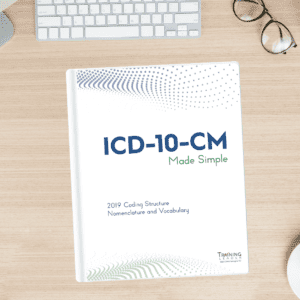
Due to the epidemic of vaping related injuries and deaths, the CDC has released ICD-10-CM Vaping Coding Guidance.
Based on what is now known about vaping or e-cigarette-related health conditions, the update contains official diagnosis coding guidance for encounters related to e-cigarette or vaping product use associated lung injury (EVALI).
The CDC is investigating the recent epidemic of vaping related injuries since the reporting of the first related death in August 2019. As of Oct. 29, 2019, 1,888 cases of EVALI have been reported and 37 related deaths have been confirmed.
EVALI is a diagnosis of exclusion because it’s a relatively new condition without a definitive diagnostic test.
Currently, other conditions must be ruled out to conclude a diagnosis of EVALI. The ICD-10-CM-Vaping-Coding guidance should be used in conjunction with current ICD-10-CM classification and the ICD-10-CM Official Guidelines for Coding and Reporting.
While examining patients, healthcare providers should explore several systemic problems and code using the following updated guidance.
Report Lung J Code for EVALI Per ICD-10-CM Vaping Coding Guidance
The aerosol inside of an e-cigarette that users inhale contains substances — such as nicotine, heavy metals, ultra-fine particles, and volatile organic compounds — that can cause harm, states the CDC. For patients documented with EVALI, you should assign specific codes related to specific conditions. A few examples include:
- 0, Bronchitis and pneumonitis due to chemicals, gases, fumes and vapors; includes chemical pneumonitis.
- 1, Pneumonitis due to inhalation of oils and essences; includes lipoid pneumonia
- J80, Acute respiratory distress syndrome
For patients with acute lung injury but without further documentation identifying a specific condition (pneumonitis, bronchitis), assign code:
- 9, Unspecified respiratory condition due to chemicals, gases, fumes, and vapors
Use T Code for Poisoning and Toxicity Related to Vaping
E-cigarettes work by heating a liquid to produce an aerosol that users inhale. The liquid can contain nicotine, tetrahydrocannabinol (THC) and cannabinoid (CBD) oils, and additional substances and flavorings.
Drinking the liquid can cause nicotine poisoning, but the liquid can also be inhaled or absorbed through the skin. For children and adults who’ve been poisoned by swallowing, breathing, or absorbing e-cigarette liquid through their skin or eyes, assign code:
- 291-, Toxic effect of other nicotine and tobacco, accidental (unintentional); includes Toxic effect of other tobacco and nicotine NOS.
For a patient with acute tetrahydrocannabinol (THC) toxicity, assign code:
- 7X1- Poisoning by cannabis (derivatives), accidental (unintentional).
Note: The hyphen indicates additional characters are required.
Code Documented Substance Use, Abuse, and Dependence Per Hierarchy
Vaping can become addictive because of the nicotine or other substance a user puts in it. It can also become habit-forming which can establish a dependence.
For patients with documented substance use, abuse, and/or dependence, assign any additional codes that identify the substances. Report the combination ICD-10-CM codes using the following sequencing hierarchy:
- If both use and abuse are documented, assign only the code for abuse.
- If both abuse and dependence are documented, assign only the code for dependence.
- If use, abuse, and dependence are all documented, assign only the code for dependence.
- If both use and dependence are documented, assign only the code for dependence.
Assign Signs and Symptoms Codes Absent EVALI Diagnosis
There are many symptoms involved in EVALI. Symptoms that have been reported by patients in the recent outbreak include:
- Cough, shortness of breath, or chest pain
- Nausea, vomiting, abdominal pain, or diarrhea
- Fever, chills, or weight loss
For patients who have signs and symptoms of EVALI without a definitive diagnosis, assign codes for each sign and symptom. For example, some of these signs and symptom codes include:
- M79.10 Myalgia, unspecified site
- R06.00 Dyspnea, unspecified
- R06.02 Shortness of breath
- R06.2 Wheezing
- R06.82 Tachypnea, not elsewhere classified
- R07.9 Chest pain, unspecified
Document: You can read the full ICD-10-CM Vaping Coding Guidance update here. Proposals for new codes will be made in March 2020, according to the ICD-10-CM Official Coding Guidelines – Supplement Coding encounters related to E-cigarette, or Vaping, Product Use update.
The CDC plans to update the guidance as new clinical information becomes available.
Recommended ICD-10-CM Training
-
 Get Paid for Patients with Vaping-Related Illnesses with New Code$277.00 – $917.00
Get Paid for Patients with Vaping-Related Illnesses with New Code$277.00 – $917.00 -
 2020 ICD-10-CM Codes Update$247.00 – $257.00
2020 ICD-10-CM Codes Update$247.00 – $257.00 -
 ICD-10-CM Made Simple: Coding Structure, Nomenclature and Vocabulary$197.00 – $917.00
ICD-10-CM Made Simple: Coding Structure, Nomenclature and Vocabulary$197.00 – $917.00
